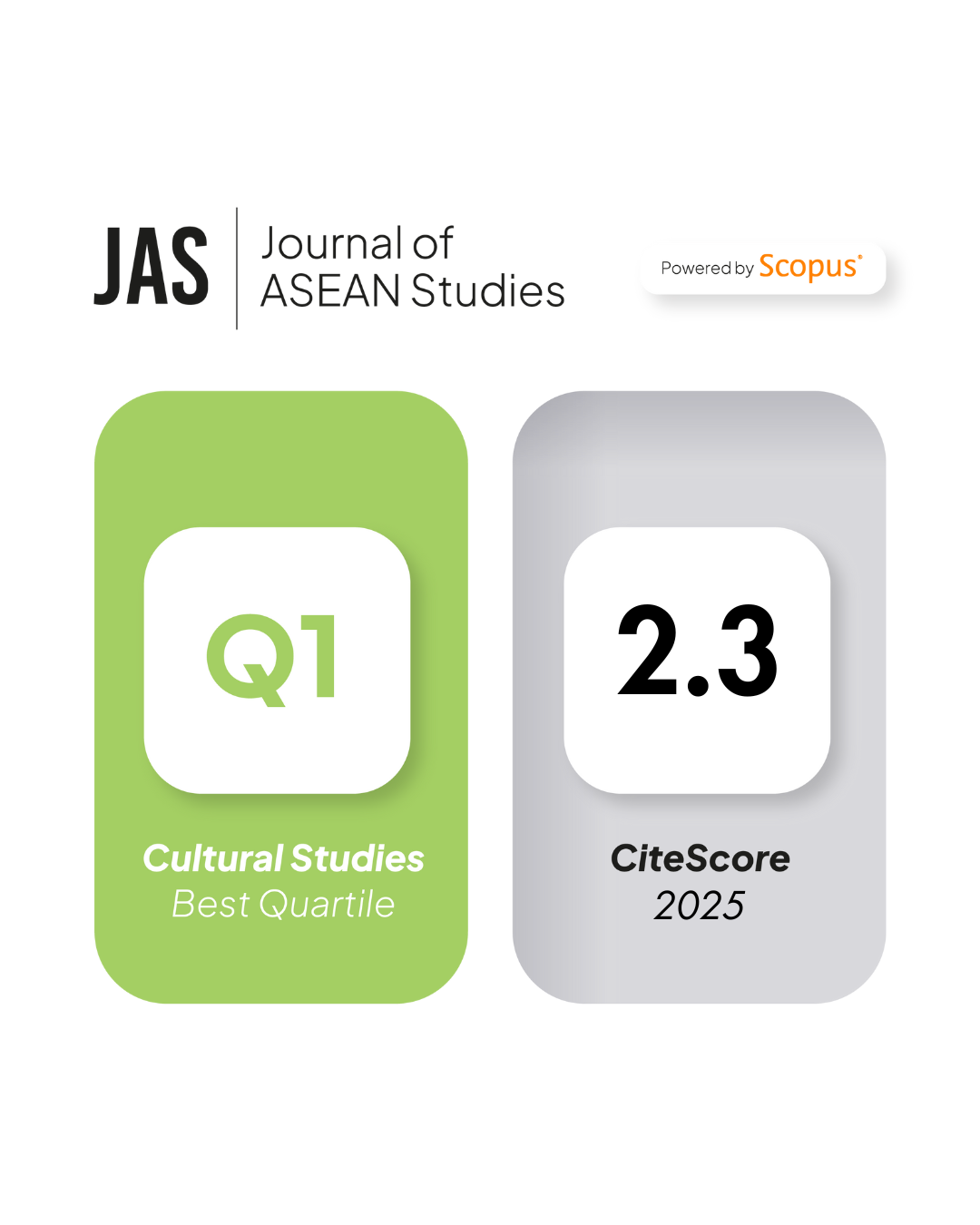The Political Economy of the Automobile Industry in ASEAN: A Cross-Country Comparison
DOI:
https://doi.org/10.21512/jas.v4i1.1536Keywords:
Political Economy, ASEAN, Automobile Industry, Globalization, Embedded LiberalismAbstract
The automobile industry plays a leading role in a country’s industrialization. Various countries have used different methods to identify a model of industrial development. For developing countries, establishing the automobile industry is crucial for promoting industrialization. After Southeast Asian countries achieved independent, their automobile industries underwent establishment and development stages. The domestic and overseas competiveness of the automobile industries in ASEAN have received global attention.
How can the industrial development of Thailand, Indonesia, Malaysia, and the Philippines, which are ASEAN countries, be understood? Researchers have proposed various views regarding the industrial development of these four ASEAN countries. We researched the political economy of these countries to understand the development of their automobile industries. Thailand’s automobile industry was successfully developed because of the government’s crucial role in implementing a coordinated market economy and national system of innovation. In Indonesia, government–business relations hampered the government’s efforts to meet  society and market needs, thereby limiting the country’s industrialization. Malaysia must learn how to coordinate its industries with a market economy through liberalization and coordination. The Philippines has positioned its automobile industry on manufacturing automotive parts because of the country’s limited industrialization.
Theoretically, following the 1997 Asian financial crisis, these ASEAN countries have adopted market economy-oriented policies; however, because of the historical context of political economy, the development of their automobile industries has varied. Under the context of globalization, the economic systems of various countries have exhibited low convergence. In this study, we show that embedded liberalism is the preferred interpretation in ASEAN automobile industry development. In other words, researchers should look beyond convergence theory and consider the political economy characteristics of various countries. Accordingly, further comparative research must be conducted to clarify the differences in the economic systems and policies in ASEAN studies.Â
References
Amsden, Alice H. 2003, The Rise of “The Rest†Challenges to the West from Late-Industrializing Economies, London: Oxford University Press.
Aswicahyono, Haryo. 2000, “How not to Industrialize? Indonesia’s Automotive Industry,†Bulletin of Indonesian Economic Studies, No. 36, Vol. 1, pp. 209-241.
Balassa, Bela. 1982. Development Strategies in Semi-Industrial Economics. Baltimore: Johns Hopkins University press.
Bello, H. Docena, W. De Guzman M. and M. Malig. 2004. The Political Economy of Permanent Crisis in the Philippines,†Quezon City: UP Department of Sociology.
Bhagwati, Jagdish. 1988. “Export-Promoting Trade Strategy: Issues and Evidenceâ€, World Bank Research Observer, Vol. 3, No.1, pp. 25-57.
Nag, Banerjee and Chatterjee(2007), “Changing Features of the Automobile Industry in
Asia: Comparison of Production, Trade and Market Structure in Selected Countries, â€
Working Papers 3707, Asia-Pacific Research and Training Network on Trade
(ARTNeT), Canada, 2007, p.26.
Bunbongkarn, Suchit. 1996, State of Nation: Thailand, Singapore: Institute of Southeast Asian Studies.
Chalmers, Ian. 1994. Domestic Capital in the Revolution of Nationalist Auto Development Policy in Indonesia: from Instrumental to Structural Power, Murdoch University Asia Research Centre working paper, No. 30.
Chalmers, Ian. 1996, Conglomeration: State and Capital in Indonesia Automotive Industry, Jakarta: Gramedia.
Chang, H. J. and W. R. Kozul, 1994. “Organizing Development: Comparing the National Systems of Entrepreneurship in Sweden and South Koreaâ€, Journal of Development Studies, No. 30, 1994, pp. 859-91.
Chang, Ha-Joon 1994, The Political Economy of Industrial Policy, London: Macmillan.
Chen, S. M. 2008. “Business and Politics in Thailand: Before and after Thaksin Shinawatraâ€. Issues & Studies, Vol. 47, No.2, pp. 151-179.
Chu, W. W. 2000. “Globalization and the Economic Development of Emerging Countries,†Taiwan: A Radical Quarterly in Social Studies, No. 47, pp. 91-114.
Chu, W. W,2001. â€Preliminary assessment of the effectiveness of Taiwan's industrial policy,†Taiwan: A Radical Quarterly in Social Studies, No. 42, pp. 67-117.
Chu, W. W. 2011. “Democratization and Economic Development: The unsuccessful transformation of Taiwan’s developmental stateâ€. Taiwan: A Radical Quarterly in Social Studies, No. 84, pp.243-288
Crouch, Harold. 1986, “The Missing Bourgeoisie: Approaches to Indonesia’s New Order, †in David Chandler and M.C. Ricklefs (eds.), Nineteenth and Twentieth Century Indonesia, Australia: Monash University.
DiMaggio Paul. J. and Walter W. Powell. 1983. “The Iron Cage Revisited: Institutional Isomorphism and Collective Rationality in Organizational Fields,†American Sociological Review, Vol. 48, No.2, pp. 147-160.
Doner, Richard F. and Wad, Peter. 2014.“Financial Crises and Automotive Industry Development in Southeast Asiaâ€, Journal of Contemporary Asia, Vol. 44, No. 4, pp. 664-687.
Doner, Richard F., Allen Hicken and K. Bryan Ritchie. 2009. “Political Challenges of Innovation in the Developing Worldâ€, Review of Policy Research, Vol. 26, Issue 1-2, pp. 151-171.
Doner, Richard. F. (1991),“Approaches to the Politics of Economic Growth in Southeast Asia, â€Journal of Asian Studies , pp. 818-849 ;
Jenkins, Rhys(1995), “The Political Economy of Industrial Policy: Automobile Manufacture in the Newly Industrializing Countriesâ€,Cambridge Journal Economics,pp.625-645.
Doner, Richrad F. 1988. “Weak State, Strong Country? the Thai Automobile Caseâ€, Third World Quarterly, Vol. 10, No.4, p. pp.1542-1564
Haggard, Stephan M. 1998. “Business Politics and Policy in East and Southeast Asia,†in Henry Rowen, Behind East Asian Growth: The Political and Social Foundations of Prosperity, New York: Routledge, pp. 78-104.
Hall, Peter and David Soskice. 2001. “An Introduction to Varieties of Capitalism,†in Peter Hall and David Soskice eds., Varieties of Capitalism: The Institutional Foundations of Comparative Advantage, New York: Oxford University Press, pp. 36-44.
Hansen, 1971, “The Motor Vehicle Industry,†Bulletin of Indonesia Economic Studies, Vol. 7, No. 2, pp. 57-58.
Hill, H. 2004. “Technology and innovation in East Asia,†in Yusuf, A. S. Altaf and K. Nabeshina (Eds.) Global Production Networking and Technological Change in East Asia, New York: Oxford University Press, pp. 354-394.
Ho, Khai Leong. 1988, Indigenizing the State: the New Economic Policy and Bumiputra State in Penunsular Malaysia, Ph. D. Diss., The Ohio State University.
Hutchcroft, Paul. 1998, Booty Capitalism: The Politics of Banking in the Philippines, Ithaca: Cornell University Press.
Rogers Hollingsworth and Robert Boyer(eds.)(1997), Contemporary Capitalism: The
Embeddedness of Institutions, New York: Cambridge University Press.
Ikemoto, Yukio. 1992, Distribution in Thailand: Its Change, Causes and Structure, Tokyo: Institute of Developing Economies.
Chalmers Johnson, 1982. MITI and the Japanese Miracle. Stanford: Stanford University Press.
Jomo, Kwame Sundaram. 2007. “Rethinking the Role of Government Policy in Southeast Asiaâ€, in Joseph E. Stiglitz and Shahid Yusuf (ed.), Rethinking the Role of Government Policy in Southeast Asia. Singapore: NUS Press, pp. 461-508.
Jomo, Kwame Sundaram. 2000. “State and Market in Economic Development: Southeast Asian Industrial Policy in Comparative East Asian Perspectiveâ€, paper present at Asia-Latin America Cooperation–ALAC An ECLAC-UN, IDE/JETRO-Japan and IE/UFRJ-Brazil Initiative, April 15 2000.
Kohpaiboon, Archanun. 2007. Thai Automotive Industry: MNCs and Global Integration, ERTC Discussion Paper 2007/4 Faculty of Economics, Thammasat University.
Kornai, János. 1998. The System Paradigm, William Davidson Institute Working Papers Series 278, William Davidson Institute, University of Michigan.
Kumon, Shumpei and Henry Rosovsky. 1972. The Political Economy of Japan: Cultural and Social Dynamics. California: Stanford University Press.
Laothamatas, Anek. 1992. Business Associations and the New Political Economy of Thailand: From Bureaucratic Polity of Liberal Corporatism, Boulder, Colo.: Westview Press.
Lim, Nenham. 2006, “ASEAN Automotive Integration- Private Sector Perspective†paper present at The 8th APEC Automotive Dialogue, Bali Indonesia.
Woo-Cumings, Meredith. 1999. “Introduction: Chalmers Johnson and the politics of nationalism and developmentâ€, in M. Woo-Cumings (ed.) The Developmental State, Ithaca, NY: Cornell University Press, pp. 1–31.
MacIntyre, Andrew. 1991. Business and Politics in Indonesia. London: Allen and Unwin.
Fujita, Mai 1998. 'Industrial Policies and Trade Liberalization? The Automotive Industry in Thailand and Malaysia' in Keiji Omura (ed.) The Deepening Economic Interndependence in the APEC Region, APEC Study Center, Institute of Developing Economies.
Malaysia Sin Chew Daily, 2006, in
http://www.sinchew-i.com/special/aplist/index.phtml?sec=723&artid=200510142558(2006/11/20)
Malaysia Sin Chew Daily. 2007. “Listed ten enterprises that held an approved permit in 2005â€,
http://www.sinchew-i.com/special/aplist/index.phtml?sec=723&artid=200507190274(2007/3/31)
Moekti Soejachmoen, P. 2011. Globalization and the Automotive Industry :Is Indonesia missing out?, Arndt-Corden Department of Economics, Working Paper, Crawford School of Economics and Government, Australian National University.
Nag, Banerjee and Chatterjee. 2007. "Changing Features of the Automobile Industry in Asia:Comparison of Production, Trade and Market Structure in Selected Countries," Working Papers 3707, Asia-Pacific Research and Training Network on Trade (ARTNeT), an initiative of UNESCAP and IDRC, Canada.
Nag, Biswajit, Saikat Banerjee and Rittwik Chatterjee, 2007, Changing Features of the Automobile Industry in Asia: Comparison of Production, Trade and Market Structure in Selected Countries, Working Papers 3707, IDEAS.
Nelson, Richard R. 1993., National systems of innovation: A Comparative Analysis, London: Oxford University Press.
Office of Industrial Economics. 2006. Ministry of Industry, Automotive Industry in Thailand, Bangkok: Office of Industrial Economics.
Office of Industrial Economics. 2010. “Master Plan for Thai Automotive Industry,†refer to
http://www.oie.go.th/policy7/Mplan/Auto/MP_Ex_Auto_en.pdf。(2010/08/01)
Office of Industrial Economics. 2015.“Master Plan for Thai Automotive Industry,†refer to
http://www.oie.go.th/policy7/Mplan/Auto/MP_Ex_Auto_en.pdf(2015/08/01)
Please refer to Indonesia Investment Coordinating Board (BKPM), 2014, website of Indonesia’s National Bureau of Statistics, http://www7.bkpm.go.id/(2014/11/28)
Rasiah, Rajah. 1999, Liberalization and the Car industry in South East Asia, Occasional Paper #99, Department of Intercultural Communication and Management, Copenhagen Business School.
Robison, Richard. 1986, Indonesia: The Rise of the Capital, London: Allen and Unwin.
Robison, Richard. 1998, “Industrialization and the Political and Economic Development of Capital: The Case of Indonesia†in Ruth McVey (ed.). Southeast Asian Capitalists, Ithaca, N.Y: Cornell Southeast Asia Program.
Rogers, Hollingsworth and Robert Boyer. 1997. Contemporary Capitalism: The Embeddedness of Institutions, New York: Cambridge University Press.
Mohamad Rosli and Fatman Kari. 2008. “Malaysia’s National Automotive Policy and the Performance of Proton’s Foreign and Local Vendorsâ€, Asia Pacific Business Review, Vol. 14, No. 1, pp. 103–118.
Ruggie, John. 1982, "International Regimes, Transactions, and Change: Embedded Liberalism in the Postwar Economic Order," International Organization, No. 36, pp. 379-415.
Soejachmoen, Moekti P. 2011. â€Globalization and the Automotive Industry: Is Indonesia missing out?†Arndt-Corden Department of Economics Working Paper, Australian National University
Soong J. J. 1996. The political and economic development of ASEAN countries, p. 279-282. Taipei: Wu-Nan Culture Enterprise.
Soskice, David. 1999. “Divergent Production Regimes: Coordinated and Uncoordinated Market Economies in the 1980s and 1990s,†in Herbert Kitschelt (eds.), Continuity and Change in Contemporary Capitalism, New York: Cambridge University Press, pp. 101-134.
Stiglitz, Joseph and Shahid Yusof. 2001. Rethinking the East Asian Miracle(New York: Oxford University Press (eds.)
Streeck Wolfgang and Kethleen Thelen. 2005. Beyond Continuity: Institutional Change in Advanced Political Economy, New York: Oxford University Press.
Tai, W. P. 2008. “The political and economic impact of economic cooperation on the industrial policies of ASEAN countries: a Case Study for the Automobile Industry in Malaysiaâ€. Asia-Pacific Forum, No. 42, pp. 53-76.
Tan, Liok Ee, 1992, â€Dongjiaozong and the Challenge to Cultural Hegemony†in Joel S. Kahn and Francis Loh Kok Wah(eds.), Fragmented Vision: Culture and Politics in Contemporary Malaysia, Australia: Allen and Unwin, pp. 208-305.
Trade Union Congress of the Philippine, 2014, “RP auto industry faces ‘make-or-break’ stage with revised MVDP -Part Iâ€, in
Wad, Peter and V. G. R. Govindaraju, 2011. C. “Automotive Industry in Malaysia: An Assessment of Its Development,†International Journal of Automotive Technology and Management, Vol. 11, No.2, pp. 152–171
Wade, Robert Hunter. 2003. “What Strategies Are Viable for Developing Countries Today? The World Trade Organization and the Shrinking of Development Space,†Review of International Political Economy, No. 4, pp. 621-644.
Xu, J. H., 2012, “Ford Motor Company closed down its factories in the Philippines at the end of 2012 to restructure regional unitsâ€. in
http://news.cnyes.com/Content/20120627/KFL0P0JWIAV1M.shtml(2012/12/13)
Zysman, John and Eileen Doherty. 1995. The Evolving Role of the State in Asian Industrialization, BRIE Work Paper 84.
Audet, D. and C. VanGrasstek. 1997. ‘Market Access Issues in the Automobile Sector, ’Market Access Issues in the Automobile Sector, OECD Proceedings, Paris: OECD.
MacIntyre, Andrew J. 1991. Business and politics in Indonesia, Australia: Allen & Unwin.
Fukuyama, Franci. 1992. The End of History and the Last Man, New York: Free Press.





















